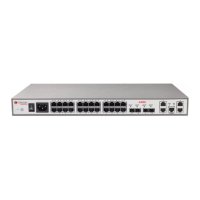A10E/A28E/A28F Configuration Guide
2 down FA 32768 0x1 0x1 0xF
Show peer system LACP interface state, flag, interface priority, administration key, operation
key, and interface state machine state on Switch A by the command of show lacp neighbor.
7.2 Interface backup
7.2.1 Introduction
In dual uplink networking, Spanning Tree Protocol (STP) is used to block the redundancy link
and implements backup. Though STP can meet users' backup requirements, but fails to meet
switching requirements. Though Rapid Spanning Tree Protocol (RSTP) is used, the
convergence is second level only. This is not a satisfying performance parameter for high-end
Ethernet switch which is applied to the Carrier-grade network core.
Interface backup, targeted for dual uplink networking, implements redundancy backup and
quick switching through working and protection links. It ensures performance and simplifies
configurations.
Interface backup is another solution of STP. When STP is disabled, you can realize basic link
redundancy by manually configuring interfaces. If the switch is enabled with STP, you should
disable interface backup because STP has provided similar functions.
Principles
Interface backup is realized by configuring the interface backup group. Each interface backup
group contains a primary interface and a backup interface. The link, where the primary
interface is, is called a primary link while the link, where the backup interface is, is called the
backup interface. Member interfaces in the interface backup group supports physical
interfaces and link aggregation groups. However, they do not support Layer 3 interfaces.
In the interface backup group, when an interface is in Up status, the other interface is in
Standby statue. At any time, only one interface is in Up status. When the Up interface fails,
the Standby interface is switched to the Up status.

